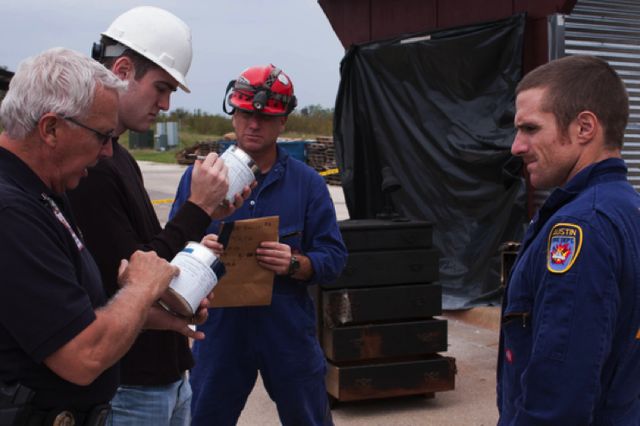An Austin College Course Emphasizes Charred Remains

Lt. Fire Investigator Brooks Frederick, left, works with Austin Community College students as they learn how to investigate possible arsons. Photo by Natalie Krebs.
By Natalie Krebs
For Reporting Texas
The 8-by-10-foot cell is charred from the inside out, closed off by yellow “caution” tape strung at least 20 feet from the nearest potential evidence. A blackened armchair, ottoman and dresser sit within the tape’s perimeter. Three Austin Community College students wearing rubber gloves gather what could be evidence: some broken glass, a pack of cigarettes and a partially melted trash can.
It’s a Tuesday meeting of the Arson II class, run by the Austin Fire Department fire investigations division. At ACC’s Fire Protection Technology program, students get hands-on experience in arson investigations as part of their training to be firefighters.
“This is much better than working out of a textbook,” says Dustin David, a 20-year-old student. He says he took the class because of an interest in arson. He’s studying to become a firefighter but says he might be interested in eventually becoming an arson investigator.
The ACC program has gained a following among prospective firefighters partly because of its emphasis on arson and other aspects of fire safety and partly because fire departments are hiring. The Austin Fire Department is looking to fill about 100 vacancies, says Division Chief Brian Tanzola, and is hoping to use federal grant money to add another 36 positions. The arson trainers from AFD are a draw, too. The team has been honored by the state for its competence. In 2010, AFD arson investigators cleared 50 percent of their cases through arrests.
This day’s instructor is Chief Fire Investigator Aaron Woolverton, a 21-year veteran of the AFD. He tells students what to look for and how to handle the fictional crime scene. Students shoot documentary pictures and write detailed reports as well as gather evidence. This class takes place on AFD’s drill field near Austin-Bergstrom International Airport. The “burn cell” is filled with Salvation Army furniture before each exercise.
The class observes the same arson-investigation standards as the AFD, which are those of the National Fire Protection Association. In 1992, Cameron Todd Willingham was convicted of starting the fire in his Corsicana, Texas, home that killed his three young children. The national standards for arson investigation were issued around the same time. Willingham was executed in 2004 despite arguments by arson experts that the evidence against Willingham was inconclusive and came from an investigator who lacked adequate training.
The widely covered Willingham case hasn’t directly changed the way Austin investigators approach arson, Woolverton said. For Austin investigators and the ACC classes, the Willingham case illustrates the importance of sticking to the national standards when interpreting arson evidence.
AFD’s investigations team has 12 members. Its job is to find out what, or who, causes fires. Members drift in and out of today’s exercise. Leo, a yellow Labrador trained to smell ignitable liquids, drops in for a sniff around.
To make exercises more realistic, the team sometimes uses parts of real cases to set up mock investigations, Woolverton says. As spite and revenge are the leading motives for arson in Austin, today’s scenario involves a person of interest who had a restraining order filed against him by a victim.
“This one would be an easy dig,” Woolverton says.
The ACC exercises, held several times a year for a decade, are good for the trainers, too, Woolverton adds. “Every time we teach a class, I learn something new,” he says.
Lt. Brooks Frederick, another fire investigator, says the learning process in Arson II is a two-way street. “It just helps reinforce my understanding because if we ever go to court we have to teach the jury what’s going on,” says Frederick, a 28-year veteran of AFD.
After three hours, the students wrap up by preparing a mock press release for Woolverton and several team members posing as members of the press. No arrests have been made at this time, the release says, and the cause of fire cannot be determined without further testing.